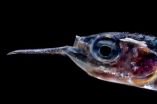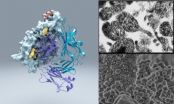(Press-News.org) With a stock estimated at 1,000 million tons so far, mesopelagic fish dominate the total biomass of fish in the ocean. However, a team of researchers with the participation of the Spanish National Research Council (CSIC) has found that their abundance could be at least 10 times higher. The results, published in Nature Communications journal, are based on the acoustic observations conducted during the circumnavigation of the Malaspina Expedition.
Mesopelagic fishes, such as lantern fishes (Myctophidae) and cyclothonids (Gonostomatidae), live in the twilight zone of the ocean, between 200 and 1,000 meters deep. They are the most numerous vertebrates of the biosphere, but also the great unknowns of the open ocean, since there are gaps in the knowledge of their biology, ecology, adaptation and global biomass.
During the 32,000 nautical miles traveled during the circumnavigation, the researchers of the Malaspina Expedition (a project led by CSIC researcher Carlos Duarte) took measurements between 40°N and 40°S, from 200 to 1,000 meters deep, during the day.
Duarte states: "Malaspina has provided us the unique opportunity to assess the stock of mesopelagic fish in the ocean. Until now we only had the data provided by trawling. It has recently been discovered that these fishes are able to detect the nets and run, which turns trawling into a biased tool when it comes to count its biomass".
Transport of organic carbon
Xabier Irigoyen, researcher from AZTI-Tecnalia and KAUST (Saudi Arabia) and head of this research, states: "The fact that the biomass of mesopelagic fish (and therefore also the total biomass of fishes) is at least 10 times higher than previously thought, has significant implications in the understanding of carbon fluxes in the ocean and the operation of which, so far, we considered ocean deserts".
Mesopelagic fish come up at night to the upper layers of the ocean to feed, whereas they go back down during the day in order to avoid being detected by their predators. This behaviour speeds up the transport of organic matter into the ocean, the engine of the biological pump that removes CO2 from the atmosphere, because instead of slowly sinking from the surface, it is rapidly transported to 500 and 700 meters deep and released in the form of feces.
Irigoyen adds: "Mesopelagic fish accelerate the flux for actively transporting organic matter from the upper layers of the water column, where most of the organic carbon coming from the flow of sedimentary particles is lost. Their role in the biogeochemical cycles of ocean ecosystems and global ocean has to be reconsidered, as it is likely that they are breathing between 1% and 10% of the primary production in deep waters".
According to researchers, the excretion of material from the surface could partly explain the unexpected microbial respiration registered in these deep layers of the ocean. Mesopelagic fishes would act therefore as a link between plankton and top predators, and they would have a key role in reducing the oxygen from the depths of the open ocean.
INFORMATION:
The Malaspina Expedition is a Consolider-Ingenio 2010 project managed by CSIC and funded by the Spanish Ministry of Economy and Competitiveness. Malaspina comprises about 50 research groups, including 27 Spanish research groups from CSIC, the Spanish Institute of Oceanography (IEO), 16 Spanish universities, a museum, the research foundation AZTI-Tecnalia, and the Spanish Navy. The total funding, in which CSIC, IEO, BBVA Foundation, AZTI-Tecnalia (as well as several Spanish universities and public research organizations) have collaborated, is about 6 millions euros.
Fish biomass in the ocean is 10 times higher than estimated
The stock of mesopelagic fish changes from 1,000 to 10,000 million tons
2014-02-07
ELSE PRESS RELEASES FROM THIS DATE:
'Steak-knife' teeth reveal ecology of oldest land predators
2014-02-07
The first top predators to walk on land were not afraid to bite off more than they could chew, a University of Toronto Mississauga study has found.
Graduate student and lead author Kirstin Brink along with Professor Robert Reisz from U of T Mississauga's Department of Biology suggest that Dimetrodon, a carnivore that walked on land between 298 million and 272 million years ago, was the first terrestrial vertebrate to develop serrated ziphodont teeth.
According to the study published in Nature Communications, ziphodont teeth, with their serrated edges, produced a more-efficient ...
Study reveals record rise in insulin use
2014-02-07
"Understanding the pattern of insulin use is limited by a lack of data characterising the prevalence of insulin use in the UK," according to Craig Currie, Professor of Applied Pharmacoepidemiology at Cardiff University's School of Medicine, who led the study alongside colleagues from the University of Bristol.
"Given the limitations, our study sought to calculate – for the first time – the best possible estimate of the rates of insulin for type 1 and type 2 diabetes."
In this retrospective study the team examined the number of patients receiving prescriptions for ...
Rett syndrome genetic variants now available for advance testing, diagnosis & research
2014-02-07
Philadelphia, PA, February 7, 2014 – Despite the identification of gene mutations in methyl CpG binding protein 2 (MECP2) being linked to Rett syndrome (RS), research has been hindered by the lack of commercially available reference materials. Through collaboration between the Centers for Disease Control and Prevention (CDC) and members of the clinical-laboratory and non-profit–research communities, 35 DNA samples containing many common RS genetic variants have now been characterized and made publicly available, eliminating a major stumbling-block for investigators and ...
New guidelines for reducing stroke risks unique to women
2014-02-06
For the first time, guidelines have been developed for preventing stroke in women.
"If you are a woman, you share many of the same risk factors for stroke with men, but your risk is also influenced by hormones, reproductive health, pregnancy, childbirth and other sex-related factors," said Cheryl Bushnell, M.D., M.H.S., author of the new scientific statement published in the American Heart Association journal Stroke.
The guidelines outline stroke risks unique to women and provide scientifically-based recommendations on how best to treat them, including:
Women with a ...
Cholesterol plays a critical role in hantavirus infection
2014-02-06
Viruses mutate fast, which means they can quickly become resistant to anti-viral drugs. But viruses also depend on proteins and nutrients provided by their hosts, and therefore one strategy to identify new anti-viral drugs is to identify and target such host-cell components. A paper published on February 6th in PLOS Pathogens reports that proteins involved in the regulation of cholesterol are essential for hantavirus entry into human host cells.
There are only about 30 known human cases of hantavirus infection in the US per year (with the 2012 cluster in Yosemite National ...
Toxin in seafood causes kidney damage in mice at levels considered safe for consumption
2014-02-06
Washington, DC (February 6, 2014) — A chemical that can accumulate in seafood and is known to cause brain damage is also toxic to the kidneys, but at much lower concentrations. The findings, which come from a study appearing in an upcoming issue of the Journal of the American Society of Nephrology (JASN), suggest that officials may need to reconsider what levels of the toxin are safe for human consumption.
The world's oceans contain algae that produce certain chemicals that can be harmful to humans and other living creatures. Many of these chemicals are considered neurotoxins ...
Acute kidney injury may be a risk factor for later heart problems
2014-02-06
Washington, DC (February 6, 2014) — Patients who experience abrupt kidney injury following surgery have an increased risk of later developing heart problems, according to a study appearing in an upcoming issue of the Journal of the American Society of Nephrology (JASN). The findings suggest that properly treating and monitoring patients with acute kidney injury (AKI) could help protect their heart health.
AKI, an sudden decline in kidney function, is an increasingly prevalent and potentially serious condition in hospitalized patients. Sometimes acute kidney injury arises ...
Reduce the chloride to restore the switch
2014-02-06
This news release is available in French. A drug given to pregnant mice with models of autism prevents autistic behavior in their offspring, a new report shows, and though the drug could not be administered prenatally in humans (there is no way to screen for autism in human fetuses), clinical trials of this drug administered later in development, in young children who have already developed autistic symptoms, are showing progress.
The causes of autism spectrum disorder, or ASD, are complex and not well understood.
Prolonged excitation of brain neurons seems partly ...
The ultimate decoy: Scientists find protein that helps bacteria misdirect immune system
2014-02-06
LA JOLLA, CA—February 6, 2014—A team led by scientists at The Scripps Research Institute (TSRI) has discovered an unusual bacterial protein that attaches to virtually any antibody and prevents it from binding to its target. Protein M, as it is called, probably helps some bacteria evade the immune response and establish long-term infections.
If follow-up studies confirm Protein M's ability to defeat the antibody response, it is likely to become a target of new antibacterial therapies. The protein's unique ability to bind generally to antibodies also should make it a valuable ...
Decoding dengue and West Nile: Researchers take steps toward control of health proble
2014-02-06
ANN ARBOR—Dengue fever and West Nile fever are mosquito-borne diseases that affect hundreds of millions of people worldwide each year, but there is no vaccine against either of the related viruses.
A team of scientists at the University of Michigan and Purdue University has discovered a key aspect both to how the viruses replicate in the cells of their host and how they manipulate the immune system as they spread.
In a study scheduled for online publication Feb. 6 in the journal Science, researchers led by Janet Smith of the U-M Life Sciences Institute describe for ...
LAST 30 PRESS RELEASES:
Safety decision-making for autonomous vehicles integrating passenger physiological states by fNIRS
Fires could emit more air pollution than previously estimated
A new way to map how cells choose their fate
Numbers in our sights affect how we perceive space
SIMJ announces global collaborative book project in commemoration of its 75th anniversary
Air pollution exposure and birth weight
Obstructive sleep apnea risk and mental health conditions among older adults
How talking slows eye movements behind the wheel
The Ceramic Society of Japan’s Oxoate Ceramics Research Association launches new international book project
Heart-brain connection: international study reveals the role of the vagus nerve in keeping the heart young
Researchers identify Rb1 as a predictive biomarker for a new therapeutic strategy in some breast cancers
Survey reveals ethical gaps slowing AI adoption in pediatric surgery
Stimulant ADHD medications work differently than thought
AI overestimates how smart people are, according to HSE economists
HSE researchers create genome-wide map of quadruplexes
Scientists boost cell "powerhouses" to burn more calories
Automatic label checking: The missing step in making reliable medical AI
Low daily alcohol intake linked to 50% heightened mouth cancer risk in India
American Meteorological Society announces Rick Spinrad as 2026 President-Elect
Biomass-based carbon capture spotlighted in newly released global climate webinar recording
Illuminating invisible nano pollutants: advanced bioimaging tracks the full journey of emerging nanoscale contaminants in living systems
How does age affect recovery from spinal cord injury?
Novel AI tool offers prognosis for patients with head and neck cancer
Fathers’ microplastic exposure tied to their children’s metabolic problems
Research validates laboratory model for studying high-grade serous ovarian cancer
SIR 2026 delivers transformative breakthroughs in minimally invasive medicine to improve patient care
Stem Cell Reports most downloaded papers of 2025 highlight the breadth and impact of stem cell research
Oxford-led study estimates NHS spends around 3% of its primary and secondary care budget on the health impacts of heat and cold in England
A researcher’s long quest leads to a smart composite breakthrough
Urban wild bees act as “microbial sensors” of city health.
[Press-News.org] Fish biomass in the ocean is 10 times higher than estimatedThe stock of mesopelagic fish changes from 1,000 to 10,000 million tons



